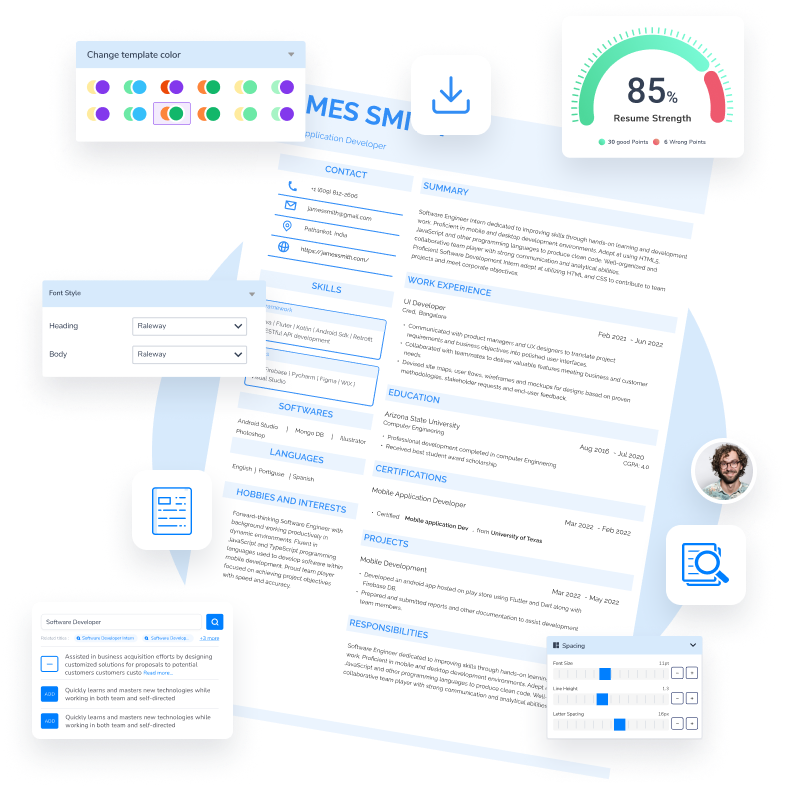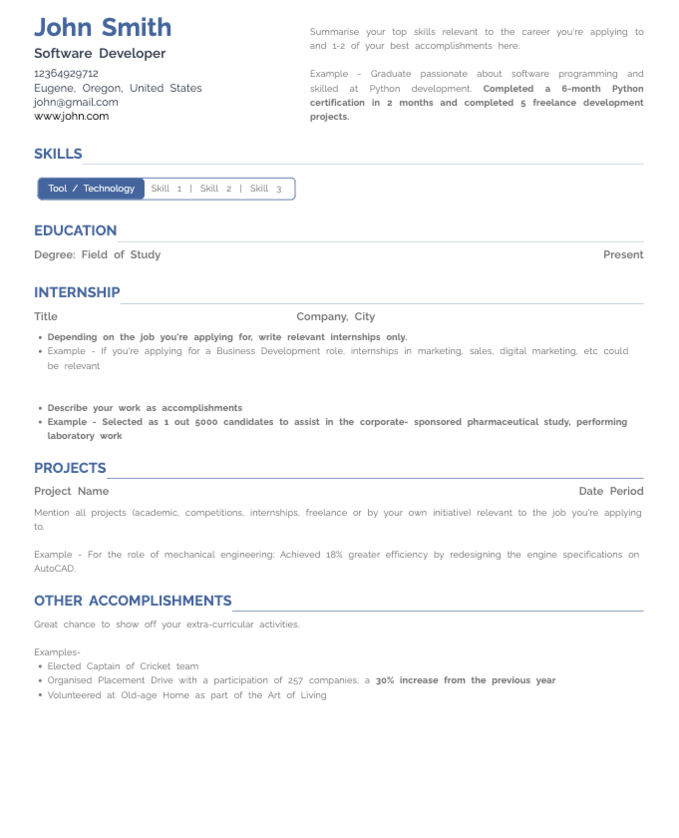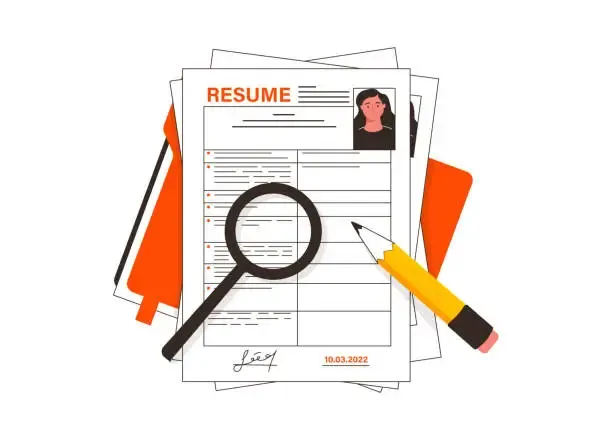250 Job Titles For a Resume [Examples for Any Profession]
5 Minutes read
![250 Job Titles For a Resume [Examples for Any Profession]](https://storage.googleapis.com/ureify-strapi-assets/resume_for_any_job_78f3082fe8/resume_for_any_job_78f3082fe8.webp)
Are you building a new resume or updating your current one for your next job hunt?
If yes, then you must remember to frame every part of it relevant to your current profile and the position you are applying for.
Most people pay attention to the big sections of a resume like work experience, skills, and education but leave the smaller sections like a job title.
Hence, we are here to frame one of the most essential yet small section of a resume, the job title by answering the following questions:
- What is a title on a resume?
- What are the things to remember while writing job titles in a resume?
- What are the things to avoid while writing job titles in a resume?
- What are the job titles that I can add to a resume?
- How to add job titles in a resume?
To simplify this entire process, you can also use any Online Resume Builder that will help you build an impactful resume in easy steps.
But for now, let's move on and learn about how you can add job titles in a resume:
The title on a resume, often referred to as the "resume title" or "resume headline," is a brief statement or phrase located at the top of your resume.
This title serves as an introduction to your resume and is meant to provide a quick overview of your professional identity and the type of role you are seeking. It's typically positioned just below your contact information.
Here are some key points to understand about the title on a resume:
- Clarity and Focus: The title should be concise and clearly state your professional focus or the specific job you are seeking. It helps the employer quickly identify your career aspirations.
- Customization: Your resume title can and should be tailored to match the specific job or industry you are applying for. A well-crafted title can immediately catch the employer's attention.
- Branding: It can serve as a form of personal branding, highlighting your strengths, skills, or the value you bring to the role.
- Relevance: The title should always be relevant to the job you are pursuing. Avoid using generic titles that don't provide information about your career goals or the position you want.
- Professionalism: Keep the title professional and avoid including personal information or unrelated details.
- "Senior Marketing Manager with Digital Marketing Expertise"
- "Experienced Software Engineer | Web Development Specialist"
- "Dedicated Registered Nurse | Pediatric Care Advocate"
- "Financial Analyst | Data-driven Financial Strategy Developer"
- "Recent MBA Graduate | Seeking Finance and Investment Opportunities"
When writing job titles in your resume, it's important to be clear, accurate, and effective in conveying your professional experience. Here are some important things to remember when including job titles on your resume:
Use Accurate and Consistent Titles
Ensure that the job titles you list are accurate representations of your roles and responsibilities. Consistency is key; use the exact titles you held in each position.
Be Specific
Whenever possible, use specific and descriptive job titles that convey your responsibilities and expertise. For example, instead of "Manager," use "Marketing Manager" or "Project Manager."
Highlight Relevant Titles
Emphasize job titles that are most relevant to the position you're applying for. If you have held various roles, consider customizing your resume by focusing on the titles that align with the job description.
Include Promotions and Changes
If you've been promoted or changed job titles within the same company, make this clear on your resume. For example, "Junior Developer (2018-2020)" and "Senior Developer (2020-Present)".
Avoid Inflated Titles
It's important to be truthful about your job titles. Using inflated or misleading titles can damage your credibility. Stick to titles that accurately represent your responsibilities and seniority.
Use Standard Industry Titles
In some industries, there are standard job titles that are widely recognized. It's often beneficial to use these standard titles to avoid confusion. For example, "Registered Nurse" or "Certified Public Accountant."
Tailor Titles for Clarity
Consider tailoring your job titles for clarity if your official title is ambiguous. For example, if your title is "Specialist III," you might write "Marketing Specialist" for better understanding.
Add Context If Necessary
If your job title doesn't fully convey the scope of your responsibilities, you can add context in your bullet points to explain what you did in that role. Be concise and specific.
Consistency in Formatting
Maintain a consistent format for presenting job titles throughout your resume. Use the same style, such as bold or italic, and formatting (e.g., capitalization) for all titles.
Omit Unnecessary Titles
You don't need to include every job title you've ever held, especially if they are not relevant to the position you're applying for. Focus on the most pertinent titles.
Things to Avoid While Writing Job Titles in a Resume
When writing job titles in your resume, there are certain common mistakes and pitfalls to avoid. Ensuring that your job titles are accurate and effectively represent your experience is crucial for a successful resume. Here are some things to avoid when including job titles on your resume:
- Exaggeration and Inflation: Avoid inflating or exaggerating your job titles to make your experience appear more senior or impressive than it actually was. Misleading titles can harm your credibility.
- Vague or Ambiguous Titles: Using vague or overly generic job titles, such as "Manager" or "Specialist," without additional context can leave recruiters and hiring managers unclear about your specific responsibilities.
- Unrelated Titles: Include only job titles that are directly relevant to the position you are applying for. Omit job titles that do not contribute to your qualifications for the role.
- Inconsistent Titles: Ensure that your job titles are consistent throughout your resume. Avoid using different variations of the same title or mixing formats (e.g., using full titles in some places and abbreviations in others).
- Including Every Job Title: You don't need to list every job title you've ever held, especially if some roles are not relevant to the job you are applying for. Focus on the most pertinent positions.
- Using Jargon: While industry-specific titles are essential, be mindful of using jargon or acronyms that may not be widely understood by all employers. If necessary, provide additional context or clarification.
- Overcomplicating Titles: While specificity is valuable, overly complex or lengthy job titles can be confusing. Use titles that are clear and concise.
- Inconsistent Capitalization: Ensure that you consistently capitalize your job titles. For instance, if you capitalize your current job title, do the same for previous titles.
- Neglecting Achievements: Job titles are important, but they should not overshadow your achievements and contributions in each role. Use your job titles as a starting point to showcase your accomplishments.
- Overemphasis on Job Titles: While job titles provide an overview of your experience, your resume should focus on showcasing your skills, achievements, and how you added value in each role. Don't rely solely on job titles to make your case.
- Failing to Explain Changes: If you've made significant career changes or transitions, consider including a brief explanation or summary to clarify why you moved from one role to another.
- Ignoring Industry Norms: In some industries, there are standardized job titles that recruiters and hiring managers are familiar with. Using unusual or non-standard titles without clarification can create confusion.
- Lack of Context: If your job title doesn't fully convey your responsibilities, provide context in the job description or bullet points to explain what your role entailed.
- Inattention to Details: Review your resume carefully for consistency, spelling, and formatting. Attention to detail is crucial when it comes to job titles.
Here is a list of 250+ different job titles that you can use on your resume. Use these as a reference, and choose the ones that align best with your experience:
- Account Manager
- Accountant
- Administrative Assistant
- Analyst (e.g., Business Analyst, Data Analyst)
- Architect
- Art Director
- Assistant Manager
- Associate (e.g., Associate Engineer)
- Auditor
- Barista
- Bartender
- Biologist
- Brand Manager
- Business Development Manager
- Buyer
- CEO (Chief Executive Officer)
- CFO (Chief Financial Officer)
- CIO (Chief Information Officer)
- CMO (Chief Marketing Officer)
- COO (Chief Operating Officer)
- Customer Service Representative
- Data Scientist
- Designer (e.g., Graphic Designer, Web Designer)
- Developer (e.g., Software Developer, Web Developer)
- Digital Marketing Specialist
- Director (e.g., Director of Sales)
- Editor
- Electrician
- Engineer (e.g., Mechanical Engineer, Civil Engineer)
- Event Coordinator
- Executive Assistant
- Financial Analyst
- Front-end Developer
- General Manager
- Graphic Artist
- Human Resources Manager
- Inspector
- Instructor (e.g., Yoga Instructor)
- Intern
- IT Specialist
- Journalist
- Lawyer
- Lecturer
- Librarian
- Maintenance Technician
- Manager (e.g., Project Manager)
- Marketing Coordinator
- Mechanic
- Medical Assistant
- Nurse (e.g., Registered Nurse)
- Office Manager
- Operations Manager
- Painter
- Paralegal
- Pharmacist
- Photographer
- Physician
- Pilot
- Plumber
- Product Manager
- Professor
- Program Manager
- Project Coordinator
- Project Manager
- Quality Assurance Specialist
- Receptionist
- Research Assistant
- Sales Representative
- Scientist
- Secretary
- Server
- Social Media Manager
- Software Engineer
- Specialist (e.g., Marketing Specialist)
- Supervisor (e.g., Shift Supervisor)
- Surgeon
- Teacher (e.g., Math Teacher)
- Technician (e.g., IT Technician)
- Therapist
- Trainer
- Translator
- Vice President (e.g., Vice President of Sales)
- Waiter
- Web Developer
- Writer
- Account Executive
- Account Coordinator
- Account Director
- Account Manager
- Accountant
- Accounts Payable Clerk
- Accounts Receivable Clerk
- Administrative Assistant
- Administrative Coordinator
- Administrative Manager
- Administrative Specialist
- Administrator
- Advertising Coordinator
- Advertising Manager
- Advisor
- Analyst (e.g., Business Analyst)
- Animator
- Application Developer
- Architect
- Art Director
- Artist (e.g., Digital Artist)
- Assistant Manager
- Associate (e.g., Associate Engineer)
- Athlete
- Attorney
- Auditor
- Author
- Baker
- Barista
- Bartender
- Benefits Administrator
- Biologist
- Blogger
- Brand Manager
- Business Analyst
- Business Development Manager
- Buyer
- CEO (Chief Executive Officer)
- CFO (Chief Financial Officer)
- CIO (Chief Information Officer)
- CMO (Chief Marketing Officer)
- COO (Chief Operating Officer)
- Caregiver
- Carpenter
- Case Manager
- Cashier
- Chef
- Chief
- Claims Adjuster
- Clerk (e.g., Administrative Clerk)
- Coach
- Communication Specialist
- Compliance Officer
- Computer Programmer
- Consultant
- Content Manager
- Controller
- Coordinator (e.g., Event Coordinator)
- Copywriter
- Counselor
- Courier
- Creative Director
- Customer Service Representative
- Data Analyst
- Data Entry Clerk
- Data Scientist
- Database Administrator
- Designer (e.g., Graphic Designer)
- Developer (e.g., Software Developer)
- Digital Marketing Specialist
- Director (e.g., Director of Sales)
- Dispatcher
- Doctor
- Editor
- Electrician
- Engineer (e.g., Mechanical Engineer)
- Event Coordinator
- Executive Assistant
- Executive Director
- Facilities Manager
- Fashion Designer
- Financial Analyst
- Flight Attendant
- Front-end Developer
- General Manager
- Graphic Artist
- HR Coordinator
- HR Manager
- Handyman
- Health Inspector
- Human Resources Manager
- Inspector
- Instructor (e.g., Yoga Instructor)
- Intern
- Interpreter
- IT Specialist
- Janitor
- Journalist
- Judge
- Laborer
- Landscape Designer
- Lecturer
- Legal Assistant
- Librarian
- Loan Officer
- Manager (e.g., Project Manager)
- Marketing Coordinator
- Mechanic
- Medical Assistant
- Merchandiser
- Mortgage Broker
- Musician
- Network Administrator
- Nurse (e.g., Registered Nurse)
- Office Manager
- Operations Manager
- Painter
- Paralegal
- Pharmacist
- Photographer
- Physician
- Pilot
- Plumber
- Police Officer
- Portfolio Manager
- Principal (e.g., School Principal)
- Product Manager
- Professor
- Program Manager
- Project Coordinator
- Project Manager
- Property Manager
- Public Relations Specialist
- Quality Assurance Specialist
- Receptionist
- Recruiter
- Research Assistant
- Researcher
- Reservations Agent
- Sales Representative
- Scientist
- Secretary
- Server
- Social Media Manager
- Software Engineer
- Specialist (e.g., Marketing Specialist)
- Supervisor (e.g., Shift Supervisor)
- Surgeon
- Surveyor
- Teacher (e.g., Math Teacher)
- Technician (e.g., IT Technician)
- Therapist
- Trainer
- Translator
- Treasurer
- Underwriter
- Vice President (e.g., Vice President of Sales)
- Video Editor
- Waiter
- Web Developer
- Writer
- Account Executive
- Account Manager
- Accountant
- Accounts Payable Clerk
Please use these titles as a reference and customize them to match your actual job titles and career experience when preparing your resume.
Adding a profile title, also known as a resume title or resume headline, to your resume can make it stand out and immediately convey your professional identity and career focus. Here's how to add a profile title effectively:
- Placement: Place the profile title at the top of your resume, just below your name and contact information. It should be one of the first things a reader sees.
- Conciseness: Keep your profile title concise, typically within 3-5 words. It should be a brief and focused statement that captures your professional identity.
- Customization: Tailor your profile title to match the specific job you're applying for. Highlight the skills or role that best align with the job description.
- "Software Engineer | Full Stack Developer"
- "Marketing Manager | Digital Marketing Expert"
- "Data Analyst | Analytics Specialist"
- "Project Manager | Agile Project Leadership"
- "Nurse Practitioner | Primary Care Provider"
- "Financial Analyst | Budget and Forecasting"
We have listed some effective guidelines on how you can add job titles in a resume along with more than 200 examples above. Still, if you are unsure about its perfection in your resume, please use HyreSnap Online Resume Builder.
It is a marvelous AI-powered resume building platform that can save your time and efforts without affecting your resume quality. Please check the highlighting offerings of this resume builder below:
You can frame the job title in your resume by following these above-mentioned guidelines. Additionally, we are listing the key takeaways below to cover everything if you missed something above:
- Use standard industry titles to parse through the ATS screening round
- Write a title showcasing your work experience and capabilities
- Always proofread your resume after completing it to remove unwanted errors
Apart from this, if you need more resume-building help, we are always available at info@hyresnap.com. Our career experts will help you craft your resume and get your next job.

Try Now for Free!


